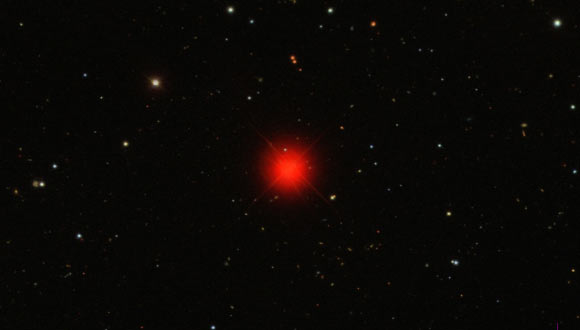Astronomers using the 305-m (1,000-foot) radio telescope at the Arecibo Observatory, Puerto Rico, recently detected ‘strange’ signals coming from Ross 128, a red dwarf star in the constellation of Virgo, just 10.96 light-years from Earth. The signals were observed only in the direction of Ross 128 and were not present in observations of other stars in the same area of the sky.

Ross 128 (center), also known as HIP 57548 or IRAS 11451+0105, is a red dwarf star. It has 15% of the mass of the Sun and 21% of the Sun’s radius, but generates energy so slowly that it has only 0.036% of the Sun’s visible luminosity. Image credit: Sloan Digital Sky Survey.
The Arecibo Observatory has a scientific campaign to observe nearby red dwarf stars.
Its purpose is to detect radio emissions from these stars, such as from flares, and to help characterize their radiation and magnetic environment and any potential perturbations due to other bodies.
The observations are led by Professor Abel Méndez, a planetary astrobiologist and NASA MIRS Fellow at the University of Puerto Rico at Arecibo, in collaboration with Dr. Jorge Zuluaga from the Universidad de Antioquia, Colombia.
“We are conducting a scientific campaign from the Arecibo Observatory to observe red dwarf star with planets,” explained Professor Méndez, who is also the Director of the Planetary Habitability Laboratory, a scientific and education laboratory dedicated to studies of the habitability of Earth, the Solar System, and extrasolar planets.
“These observations might provide information about the radiation and magnetic environment around these stars or even hint the presence of new sub-stellar objects including planets.”
In April-May 2017, Professor Méndez and his colleagues observed Ross 128 and several other red dwarfs (Gliese 398, Gliese 436, Wolf 359, HD 95735, BD +202465, and K2-18).
“Two weeks after initial observations, we realized that there were some very peculiar signals in the 10-min dynamic spectrum that we obtained from Ross 128, observed on May 12,” Professor Méndez said.
“The signals consisted of broadband quasi-periodic non-polarized pulses with very strong dispersion-like features.”
The researchers believe the signals are not local radio frequency interferences.
“The signals are unique to Ross 128 and observations of other stars immediately before and after did not show anything similar,” Professor Méndez said.
“We do not know the origin of these signals, but there are three main possible explanations:
(i) emissions from Ross 128 similar to Type II flares;
(ii) emissions from another object in the field of view of Ross 128;
(iii) burst from a high orbit satellite since low orbit satellites are quick to move out of the field of view.”
“Each of the possible explanations has their own problems,” he said.
“In case you are wondering, the recurrent ‘aliens hypothesis’ is at the bottom of many other better explanations.”
“We have a mystery here and the three main explanations are as good as any at this moment,” Professor Méndez added.







